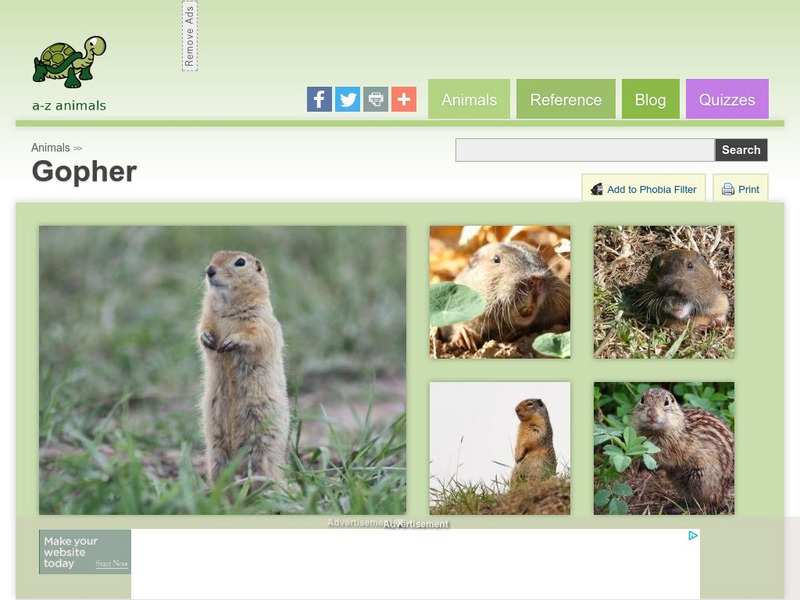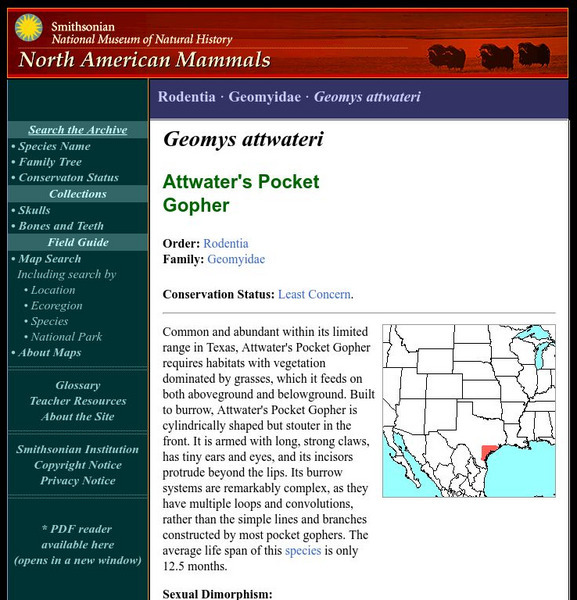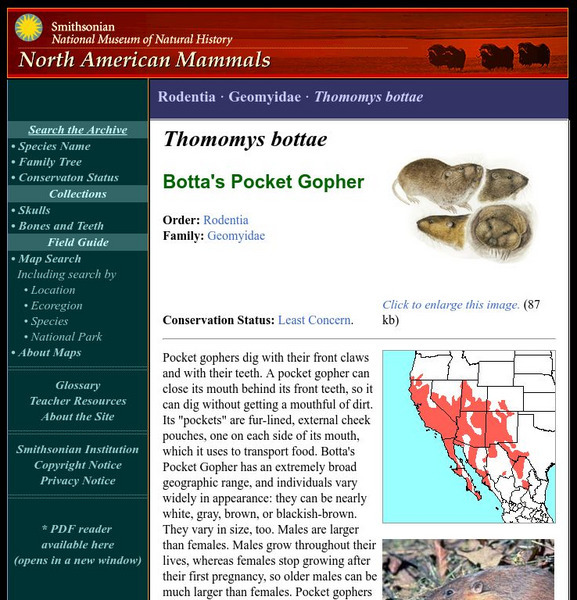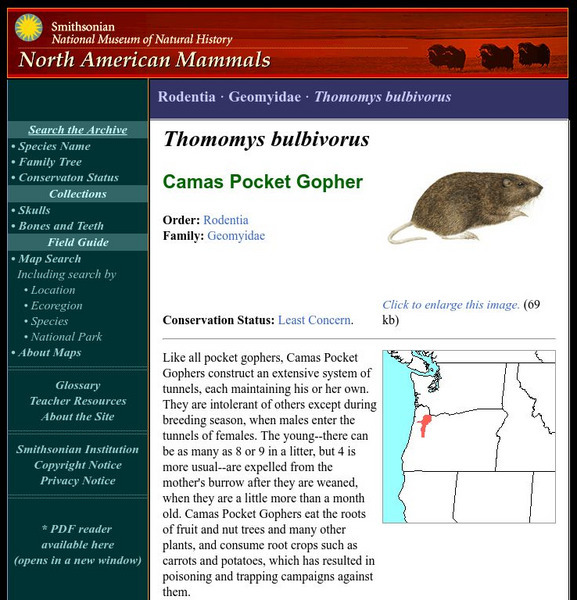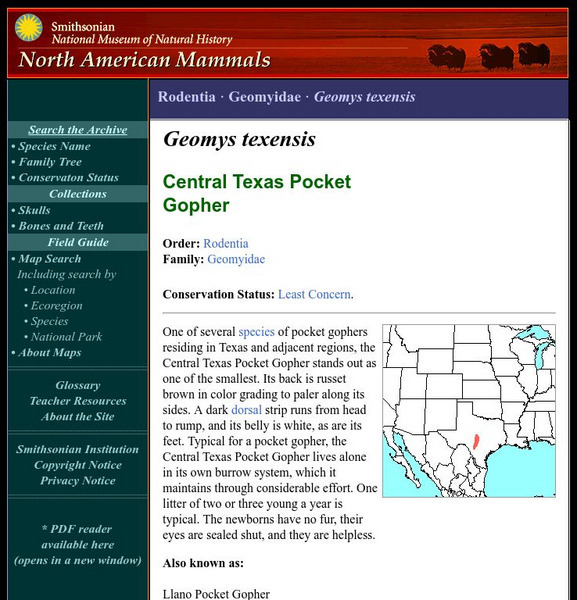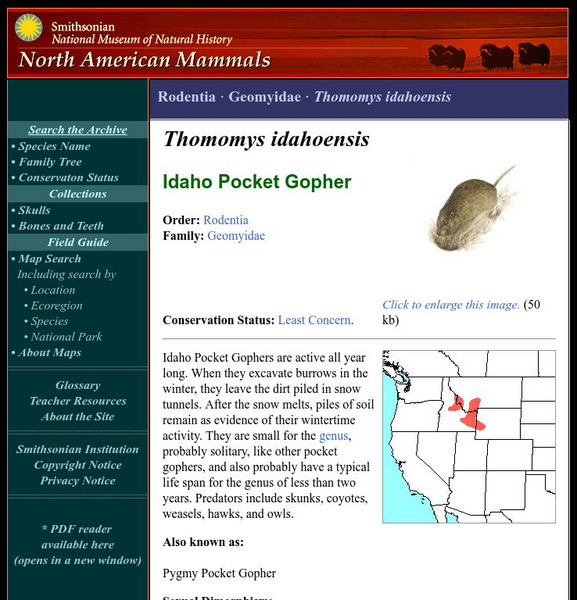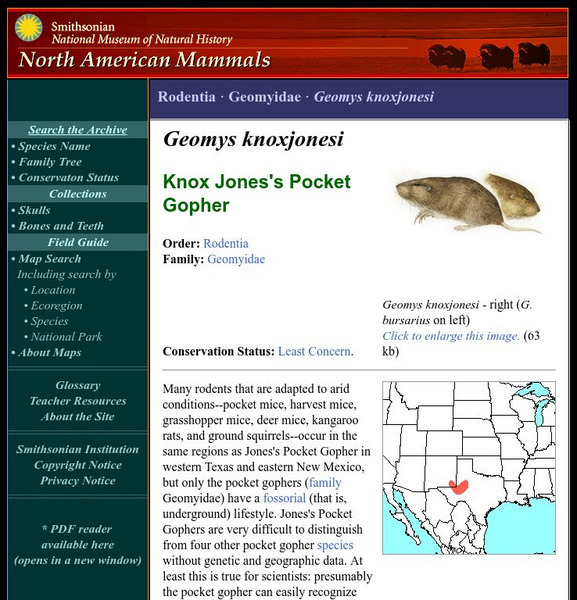Other
History of the Russian Settlement at Ft. Ross,california
Details Russian expansion across Asia, over the Bering Strait to Alaska, and then down the coast to California. Their settlement, relations with the Spanish, life in Ft. Ross, and departure are chronicled here.
A-Z Animals
A Z Animals: Animal Facts: Gopher (Spermophilus Richardsonii)
This entry identifies the defining characteristics of Spermophilius Richardsonii, more commonly known as the Gopher.
Smithsonian Institution
National Museum of Natural History: American Mammals: Attwater's Pocket Gopher
Common and abundant within its limited range in Texas, Attwater's Pocket Gopher requires habitats with vegetation dominated by grasses, which it feeds on both aboveground and belowground. Built to burrow, Attwater's Pocket Gopher is...
Smithsonian Institution
National Museum of Natural History: American Mammals: Botta's Pocket Gopher
Pocket gophers dig with their front claws and with their teeth. A pocket gopher can close its mouth behind its front teeth, so it can dig without getting a mouthful of dirt. Learn more about the Thomomys bottae, more commonly known as a...
Smithsonian Institution
National Museum of Natural History: American Mammals: Camas Pocket Gopher
Like all pocket gophers, Camas Pocket Gophers construct an extensive system of tunnels, each maintaining his or her own. They are intolerant of others except during breeding season, when males enter the tunnels of females. Learn more...
Smithsonian Institution
National Museum of Natural History: American Mammals: Baird's Pocket Gopher
Baird's Pocket Gopher is also known as the Louisiana Pocket Gopher, though most of what is known about its ecology has come from studies of the species near College Station, Texas, and it occurs in Oklahoma and Arkansas as well as in...
Smithsonian Institution
National Museum of Natural History: American Mammals: Plains Pocket Gopher
The Plains Pocket Gopher is a medium-size rodent with a disproportionately massive front end, including an impressive head and strong, curved claws. Its diet consists mostly of roots and tubers located by tunneling through loose soil....
Smithsonian Institution
National Museum of Natural History: American Mammals: Texas Pocket Gopher
Only soils with low percentages of silt, clay, and gravel will do for the Texas Pocket Gopher, so many of its populations are isolated from one another. The species occurs in southern Texas and extreme northeastern Mexico, burrowing in...
Smithsonian Institution
National Museum of Natural History: American Mammals: Yellow Faced Pocket Gopher
The Yellow-faced Pocket Gopher feeds on starchy, tuberous roots of desert shrubs and on the roots and leaves of low-growing forbs. Like other pocket gophers, this species is considered an agricultural pest, doing extensive damage in...
Smithsonian Institution
National Museum of Natural History: American Mammals: Wyoming Pocket Gopher
Wyoming Pocket Gophers are known only from a small area in south-central Wyoming. These rather small Pocket Gophers seem to prefer loose, gravelly, upland soils, often where greasewood is growing. Learn more about the Thomomys clusius,...
Smithsonian Institution
National Museum of Natural History: American Mammals: Southeastern Pocket Gopher
Equipped for a subterranean life, the Southeastern Pocket Gopher's muscular front legs, thick-set front body, massive claws on its front feet, small eyes and ears, and incisors protruding beyond the lips are obvious adaptations to life...
Smithsonian Institution
National Museum of Natural History: American Mammals: Desert Pocket Gopher
The Desert Pocket Gopher is built for digging, with strong front legs and massive claws. Small eyes and ears are adaptations for traveling through tunnels. Learn more about the Geomys arenarius, more commonly known as a Desert Pocket...
Smithsonian Institution
National Museum of Natural History: American Mammals: Llano Pocket Gopher
One of several species of pocket gophers residing in Texas and adjacent regions, the Llano Pocket Gopher stands out as one of the smallest. Its back is russet brown in color grading to paler along its sides. Learn more about the Geomys...
Smithsonian Institution
National Museum of Natural History: American Mammals: Idaho Pocket Gopher
Idaho Pocket Gophers are active all year long. When they excavate burrows in the winter, they leave the dirt piled in snow tunnels. Learn more about the Thomomys idahoensis, more commonly known as an Idaho Pocket Gopher, in this...
Smithsonian Institution
National Museum of Natural History: American Mammals: Jones's Pocket Gopher
Many rodents that are adapted to arid conditions--pocket mice, harvest mice, grasshopper mice, deer mice, kangaroo rats, and ground squirrels--occur in the same regions as Jones's Pocket Gopher in western Texas and eastern New Mexico,...
Smithsonian Institution
National Museum of Natural History: American Mammals: Western Pocket Gopher
As is the case with a number of pocket gopher species, most aspects of the Western Pocket Gopher's life have not yet been studied. This Pocket Gopher lives in rich volcanic soils of alpine meadows and small glacial prairies, west of the...
Smithsonian Institution
National Museum of Natural History: American Mammals: Northern Pocket Gopher
Of all North American pocket gophers, the Northern Pocket Gopher has the widest distribution, across most of the western United States and south-central Canada, and it occurs in the greatest variety of habitats. Only habitats with a...
Smithsonian Institution
National Museum of Natural History: American Mammals: Townsend's Pocket Gopher
Townsend's Pocket Gophers require deep, moist soils of river valleys and ancient lake beds. Other pocket gophers that are found in the same region, in the northern Great Basin, prefer different soil types: Botta's Pocket Gopher is...
Smithsonian Institution
National Museum of Natural History: American Mammals: Southern Pocket Gopher
Because most Southern Pocket Gophers live at high elevations in the mountains of Mexico, they are less accessible, and have been less-studied, than some other species. Like all pocket gophers, they are vegetarians, consuming both...
Smithsonian Institution
National Museum of Natural History: American Mammals: Mountain Pocket Gopher
Mountain Pocket Gophers live in meadows, pastures, and rocky slopes, in pine, fir, spruce, and hemlock forests at elevations above 1,545 m. They are active all year, and like other pocket gophers, they are solitary. Learn more about the...



